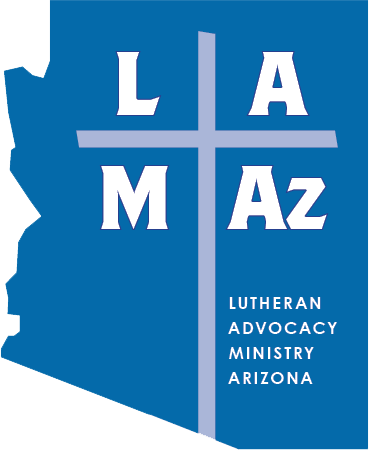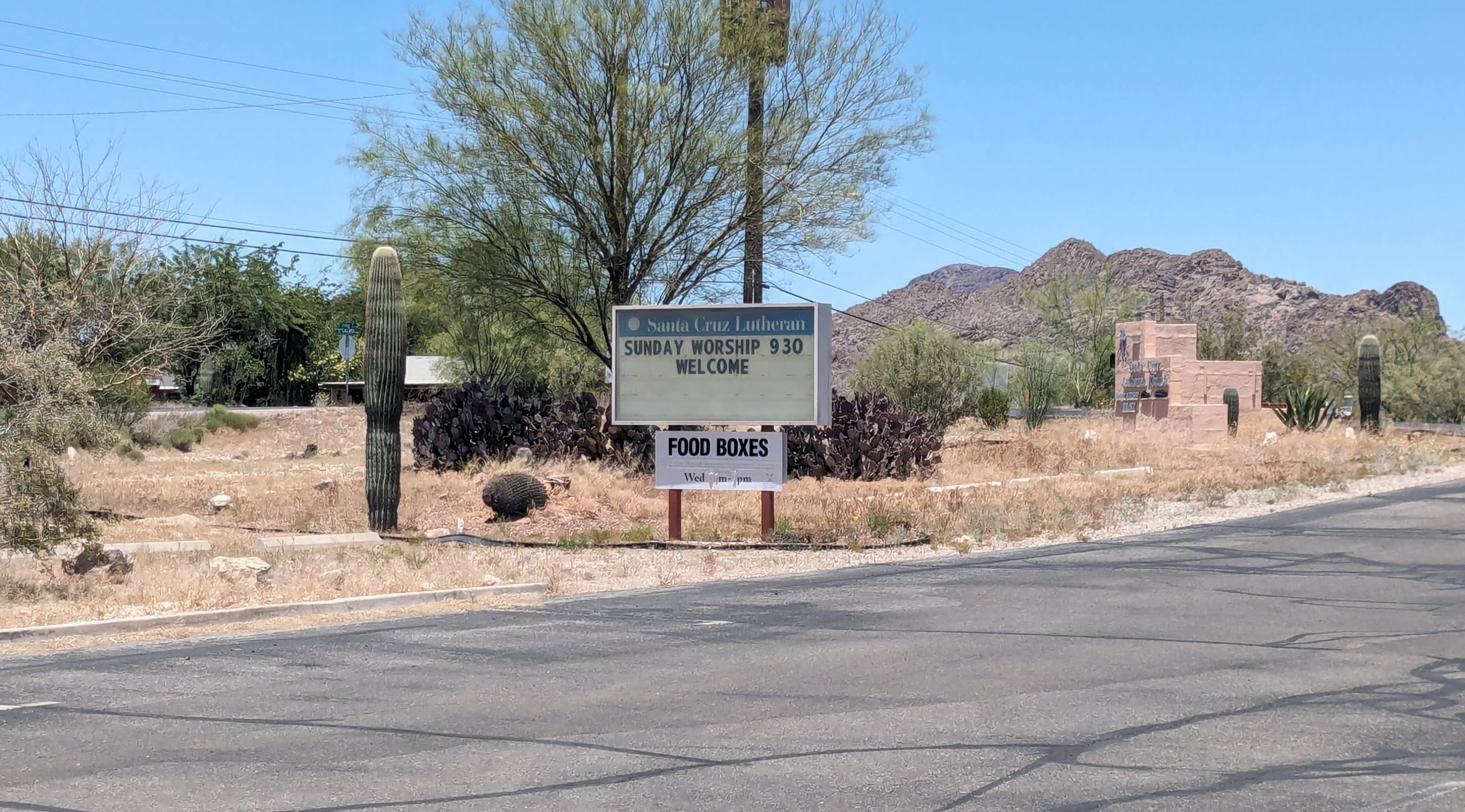Community Spotlight: Santa Cruz Lutheran Food Bank
Back in May, I made a round of visits to ministries in the Tucson area. While there, Pastor Bob Jones from Santa Cruz Lutheran Church (one of LAMA’s Policy Council members!) made sure to put me to work at the Santa Cruz Lutheran Food Bank.
The Food Bank at Santa Cruz is the passion project of one particular member: Joanie Contreras. After a career in teaching and long term involvement with food banks in the area, Joanie recognized the need in Santa Cruz’s neighborhood. Like many churches, the congregation decided to turn some unused space, this time about half of the fellowship hall, into a pantry open to community members that need help.
The Santa Cruz Lutheran Food Bank is only open one day a week, on Wednesdays, but they are open from 11 am to 7 pm— well into the evening. This means that people can stop by after work or at times that fit into their schedules, which makes them a popular pantry. Santa Cruz sits in the southern part of Tucson, right where the city transitions into the rural area around it. The San Xavier reservation (which is part of the Tohono O’odham Nation) extends to the south and east, and the Pascua Pueblo is just to the west. The Tohono O’odham Nation Reservation is also nearby. Like all Indigenous communities, food insecurity is elevated in these areas. Food insecurity in rural areas is also on the rise, and Santa Cruz Lutheran Food Bank serves clients from all of these areas. On the Wednesday of my visit, I was put right to work.
Sharing table
Community board
We all know that food insecurity has more causes than just a person’s physical proximity to food. While geographic inaccessibility is definitely a factor for clients at Santa Cruz, so are factors that many Americans face: rising food prices, high cost of living, and low wages. The Santa Cruz Food Bank has taken it as their mission to help folks stretch their budgets; any extra money that a person can save helps put food on the table. This means that Santa Cruz offers more than just boxes of food; when I first made my way across the parking lot, this was immediately evident. In the morning and early afternoon, a representative from Oak Street Health, a network of clinics for adults on Medicare, greeted visitors from a table promoting their low-cost health care services. An orange sandwich-board labeled “COMMUNITY” hosts fliers for resources and upcoming local events. Near the door of the pantry, a small folding table invites folks to swap clothing items they no longer need for ones they can use, along with a cart full of books and school supplies. Visitors can enter to pantry one at a time, where the shelves in the entry way hold children’s toys, cards with easy recipes, and fliers for other services around Tucson.
Another way the Santa Cruz Food Bank helps its community optimize their budgets is through the semi-regular resource fairs facilitated with the AZUL initiative of the Sahuarita Food Bank (stay tuned for an article detailing their partnership!) A couple of times a month, all sorts of community resources, including English as a Second Language courses, GED programs, mobile health clinics, a bookmobile, and community advocates from the governor’s office all set up in the Santa Cruz parking lot to offer people a helping hand.
Entry desk
The Santa Cruz Lutheran Food Bank is, like most of the pantries in the Tucson area, a partner of Community Food Bank of Southern Arizona. Community Food Bank limits clients to two of their food boxes per month. Like at most food banks, the first step here is to present an ID; the volunteer at the desk checks it against their database. Luckily, if someone shows up in need, the food bank usually has enough of its own supplies to give out, even if someone has already received their monthly allotment from Community Food Bank.
Today’s allotment, based on family size
A holdover from the pandemic, only one client is allowed in at a time. After they are checked in, the volunteer at the desk tells the rest of us how many family members the client is picking up for. The visitor then exists, walks down to a second door, and is greeted by another volunteer. The volunteer then opens one of the many coolers and places an allotment of frozen meet, today it’s fish, into the shopping cart at the door. Volunteers also retrieve other cold items, like breakfast meats and ice cream, as well as a box of supplies from the Community Food Bank and a pre-assembled box of other groceries, all according the the visitor’s family size. The pantry also gives out pet supplies upon request.
The Santa Cruz Food Bank sources its food from a few places; in addition to donations from the congregation, the food bank runs its own grocery rescue program. Joanie and her team slowly built relationships with stores in the area, and now they regularly pick up products that have been overstocked or are set to be discarded. This serves two important purposes: it ensures that the food bank always has supplies, and it keeps food out of the landfill. All of this food is sorted into refrigerators (purchased through a grant from ELCA World Hunger!) and on wire shelves. On the shelves, the items are sorted by type (veggies, meat, crackers, extras, etc.). Volunteers then place on of each type of item in a grocery bag; the bags are then placed into a carboard box, along with a bread product and a bag of fruit (today its apples!). This way, the volunteers at the door are able to easy allocate the amount each client needs.
Boxes and shelves of food
Joanie firmly believes that the volunteers are what makes the Food Bank possible. She makes sure to always have a fresh pot of coffee, and on the day of my visit, we split a couple frozen pizzas together. Interestingly, a handful of the most involved volunteers are not affiliated with Santa Cruz, or any church in the area. Still, they work hard at the pantry every week to care for their community.
The traffic at the pantry ebbs and flows throughout the day, though I’m told that it is a relatively slow day. Luckily, no one has to spend long standing in line in the heat. Since the pantry is open for the whole day, volunteers rotate in and out. I’m told that there is usually an after-work-rush in the evening as folks take advantage of the bank’s late hours.
The Santa Cruz Lutheran Food Bank has a distinct approach to sharing the love of Christ with their neighbors. Every food bank has its own outlook and priorities, and Santa Cruz takes a more wholistic view than some. In hoping to help folks stretch their budgets, they have found themselves doing much more than distributing food. Joanie and her volunteers are always working on something new to help address the causes of hunger in southern Tucson, the nearby reservations, and the surrounding area. Its bred a community which orbits around Santa Cruz, bring volunteers and clients both into Christ’s love. I can’t wait to see what they do next!








